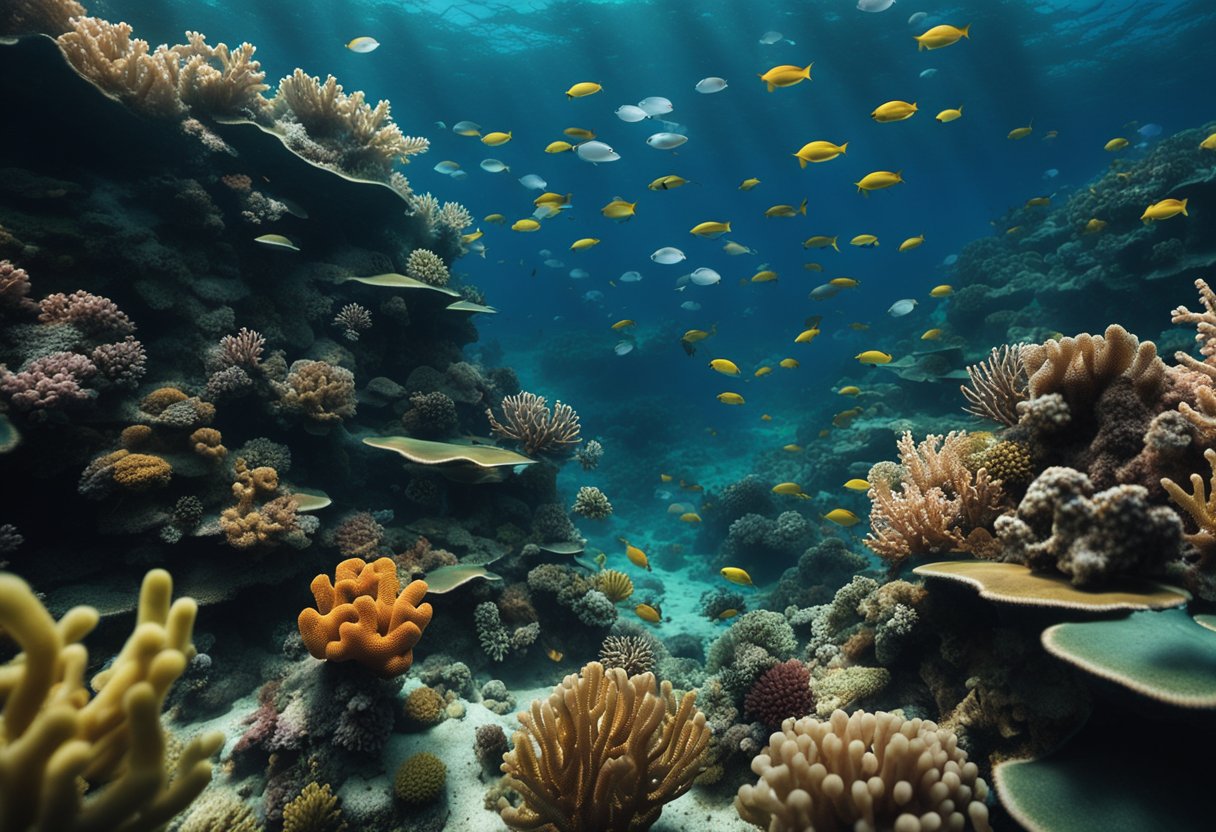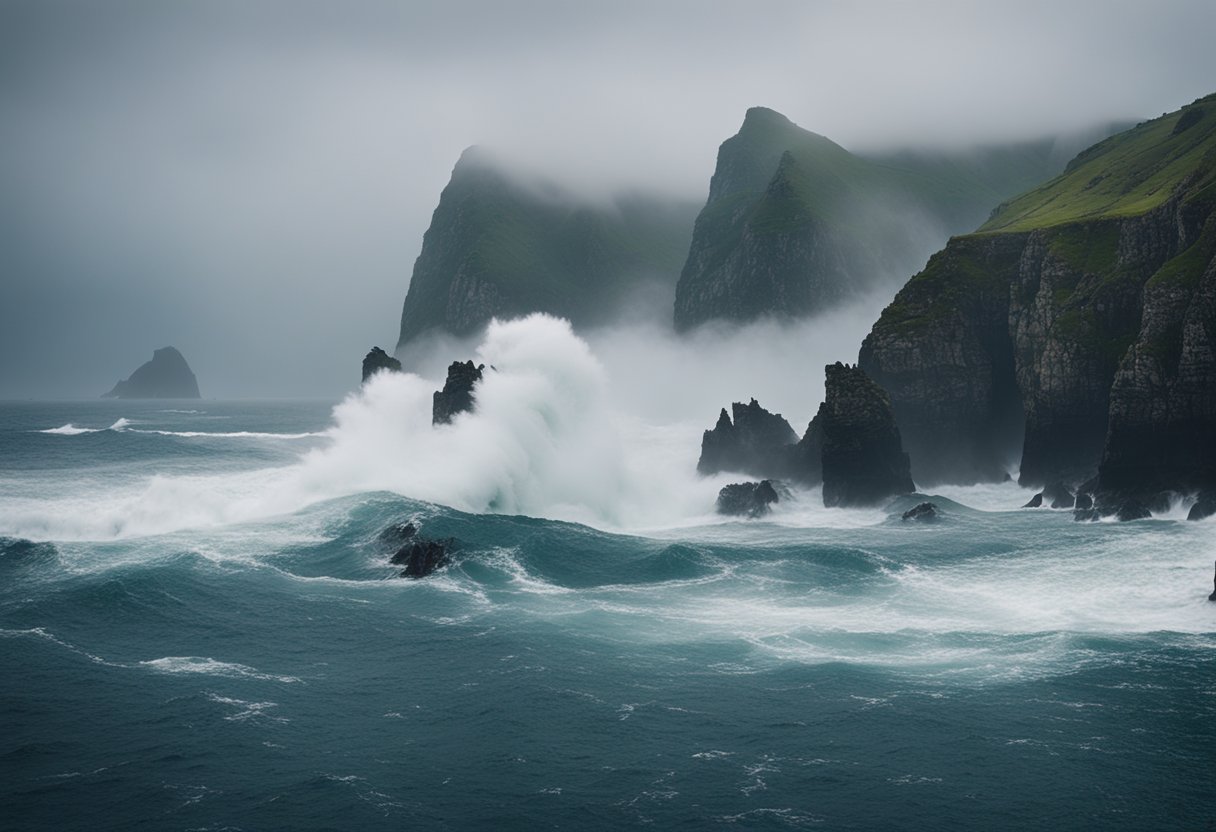World’s End Explored: A Guide to Earth’s Final Frontiers!

Updated On: March 21, 2024 by Esraa Mahmoud
Exploration has always been at the heart of the human spirit, compelling us to journey beyond the horizon to discover places unknown. Some regions remain mysterious as we seek out these uncharted territories, earning the moniker of ‘Earth’s final frontiers’. These remote destinations, often situated where the maps end, beckon to the intrepid explorer in all of us, promising adventure and the thrill of the undiscovered.
Enshrouded in an enigma, the deep-sea and remote southern landscapes offer some of Earth’s most compelling and least understood environments. Our oceans’ abyssal plains, mountainous seafloors, and the icy expanses of the Southern Ocean conceal myriad secrets, from unique ecosystems to geological wonders, all awaiting revelation through advancing oceanographic exploration. Visiting these final frontiers is not merely a journey through space but also a passage through time, a chance to witness the complexity and resilience of life in its most extreme forms.
Earth’s Final Frontiers: The Allure of the Deep Sea
The deep sea beckons us with its mysterious allure, urging us to explore the oceanic trenches that remain Earth’s least understood frontiers. Within these profound depths, creatures and ecosystems thrive in conditions unfathomable to our surface-dwelling sensibilities. The deep sea represents one of the final puzzles in our quest to comprehend our planet fully.
Curiosity drives us to these dark, high-pressure environments. Technological advances have enabled us to breach the abyssal plains and witness wonders far beneath the waves. Submersibles descend to the seafloor, bringing back tales of otherworldly life forms, geological marvels, and the history recorded in the sediments.
- Exploration of the deep sea allows us a glimpse of life’s adaptability, where organisms flourish without sunlight.
Our fascinated gaze turns to the oceans’ depths as we seek to understand Earth’s biodiversity and the limits of life itself. Studying these remote habitats informs us about our world’s past and present and helps us envision potential futures in the endless oceanic expanses.
We navigate dark waters, charting previously unexplored terrain with each scientific expedition. This knowledge empowers us to protect better the marine biodiversity that relies on the deep sea’s unique environment to survive.
The call of the deep sea is one of discovery and responsibility – an invitation to witness Earth’s enigmatic depths, protect its hidden treasures, and continue our journey towards an ever-greater understanding of the blue heart of our planet.
Unveiling the Seafloor’s Mysteries

Exploring the ocean’s depths has unveiled remarkable ecosystems, and sophisticated technologies like sonar have been pivotal in these discoveries.
Seafloor Mapping
Seafloor mapping is an ongoing endeavour that reveals landforms and potential habitats that enhance our understanding of aquatic life. Notably, initiatives such as the Nippon Foundation-Gebco Seabed 2030 Project aim to map the ocean floor by 2030. So far, significant progress has been made, with one-fifth already charted. This helps in scientific discovery, improving navigation for maritime travel, and understanding seismic risks.
Sonar Technology
Sonar technology is crucial in investigating undersea landscapes, enabling us to penetrate the ocean’s dark depths. Institutions like the Monterey Bay Aquarium Research Institute utilise sonar to scan the seabed, revealing everything from the contours of submerged mountains to the deep trenches that have remained untouched by sunlight for millennia. This technology is indispensable in revealing hidden ecosystems and new species that call the ocean floor home.
Life Under Extreme Pressure

Life has adapted to survive under extreme pressure in the most inhospitable environments on Earth. Here, we explore the remarkable strategies and organisms that thrive where few others can.
Adaptations
Remarkable biological adaptations facilitate the survival of life under extreme pressure. At depths of over 400 meters, or 1,300 feet, the pressure is about 400 times greater than at sea level, meaning organisms must have specialised adaptations to cope. These include unique enzymes that function optimally in high-pressure environments and cellular structures that protect against physical deformation. In particular, the composition and fluidity of cell membranes are vital in maintaining cell integrity and function.
Deep-Sea Organisms
Various organisms inhabit these deep, pressured worlds, contributing to the vast and uncharted biodiversity. This subterranean life constitutes a significant portion of Earth’s biomass. Microbial life, for instance, is exceptionally abundant; a group of international scientists has reported incredible quantities of life deep below Earth’s surface. Furthermore, deep-sea creatures, such as those found around hydrothermal vents, flourish in conditions with pressures over 10 MPa, demonstrating the resilience and adaptability of life in the face of extreme pressures.
Diving into the Abyss
In the pursuit of uncovering the secrets of Earth’s final frontiers, we direct our attention to the profound depths of the ocean, where the thrill of discovery awaits in the mysterious abyss.
Submersibles
Our journey to the deep ocean begins with submersibles – sophisticated vessels that allow us to penetrate the abyss. These robust underwater crafts are designed to withstand colossal pressures beyond human endurance. They are equipped with state-of-the-art technology that includes manipulator arms for sampling and high-definition cameras to document the uncharted depths. Thanks to advancements in submersible engineering, we can now conduct scientific research and exploration in inaccessible areas.
Victor Vescovo’s Expeditions
One explorer who has notably contributed to our understanding of the abyss is Victor Vescovo, the mastermind behind The Five Deeps Expedition. His deep-sea dives have taken him to the deepest points of each of the world’s five oceans using a specially built submersible. Vescovo’s expeditions have pushed the boundaries of human exploration and given us invaluable insights into the ecosystems of our planet’s most isolated regions. His record-setting dive to the Challenger Deep in the Mariana Trench marked one of the deepest manned sea dives, establishing Vescovo as a vanguard of oceanic adventure.
The Southern Ocean’s Secrets

The Southern Ocean, encircling the icy continent of Antarctica, has long captivated us with its remote and untamed nature. This vast expanse is pivotal in influencing Earth’s weather patterns and supporting a unique ecosystem.
Biodiversity & Ecosystem
Home to an astonishing array of wildlife, the Southern Ocean’s harsh conditions have given rise to specialised species. From the colossal blue whale to the diminutive krill, life here studies adaptation and survival. The ocean’s circumpolar current isolates its inhabitants, fostering a unique ecosystem that teems with species unseen elsewhere.
- Krill: Forming the base of the ecosystem, they are crucial for the survival of many marine species.
- Marine Mammals: Includes seals and whales, which thrive in these nutrient-rich waters.
- Seabirds: Iconic species such as the wandering albatross call this ocean home, soaring over vast distances.
Our understanding of the Southern Ocean grows with every expedition that braves its frigid waters. The region’s importance extends beyond its awe-inspiring wildlife; it also plays a vital role in our global climate system by regulating carbon dioxide and supporting extensive carbon sinks.
Despite its remoteness, human activities pose a threat to this pristine environment. We increasingly know the need to protect the Southern Ocean’s delicate ecosystem. Its conservation is crucial for the diverse life it supports and the health of our planet as a whole.
Advancements in Oceanographic Exploration
As we examine the leaps in technology that drive the study of our oceans, it’s clear that innovation is key. Cutting-edge tools and dedicated research institutions propel oceanography into new depths, broadening our understanding of this vast frontier.
Robotic Explorers
Robotic explorers, such as Autonomous Underwater Vehicles (AUVs) and Remotely Operated Vehicles (ROVs), have revolutionised our capacity to investigate the deep seas. AUVs, like those developed by Woods Hole Oceanographic Institution, are unmanned submarines pre-programmed to collect data across large oceanic expanses, often reaching areas too dangerous for humans. On the other hand, ROVs are operated in real-time and can gather samples and images, providing direct interaction with the marine environment. Oceanographers gain invaluable insights through these robots, from mapping the ocean floor to monitoring marine biodiversity.
Research Institutions
Research institutions worldwide, including universities and dedicated oceanographic centres, are the backbone of advancements in ocean exploration. Universities often collaborate with institutions like Woods Hole, pooling resources and expertise to push the boundaries of what’s possible under the waves. These partnerships result in scientific breakthroughs and the development of new exploration methods, fostering an environment where education and discovery go hand in hand. Through their efforts, we’re unveiling the ocean’s mysteries and training the next generation of ocean scientists.
Climate Change and the Oceans
The health of our oceans is intricately tied to the broader impacts of climate change. Rising ocean temperatures and the disruption of polar ecosystems offer a glimpse into these profound changes. We’ll explore how these shifts signal alterations in our marine environments and affect global climate patterns.
Rising Temperatures
Oceans are our planet’s largest solar energy absorbers, maintaining the Earth’s energy balance. As greenhouse gases such as carbon dioxide trap more heat in the atmosphere, sea surface temperatures have seen a significant uptick. Research shows oceans have warmed by more than 1.5 °C, affecting everything from coral reefs to ocean current patterns. The consequences are multi-faceted, resulting in sea level rise, acidification, and a reduction in species diversity. Warmer oceans also contribute to more intense and frequent extreme weather events, disrupting lives and ecosystems on land.
Polar Ecosystems
The Arctic is experiencing climate change at a rate almost twice the global average, prompting unprecedented alterations in polar ecosystems. Shrinking sea ice is not only a symptom of rising temperatures, but also a contributor to further warming as the dark ocean absorbs more sunlight previously reflected by ice. These changes disrupt the life cycles of indigenous species and threaten entire food webs. As polar ice melts, it increases sea levels, posing a risk to coastal communities worldwide. Furthermore, the thawing of permafrost releases additional greenhouse gases, exacerbating global warming.
Our understanding of these issues stems from credible sources, including the UN’s insights into how climate change impacts the world’s oceans and studies on ocean warming. We must address these concerns through informed policy and sustainable practices to mitigate further damage and preserve our marine environments for the future.
Biodiversity in Ocean Ecosystems
The ocean’s vast ecosystems are brimming with life, hosting many species contributing to the planet’s biodiversity. The discovery of new species and the range of habitats reflect the ocean’s critical role in supporting Earth’s biological diversity.
New Species Discovery
Exploring ocean ecosystems has led to the discovery of new species, enriching our understanding of marine biodiversity. These discoveries are fascinating in their own right and crucial for conservation efforts and studies on evolutionary biology. Recently, a research project focusing on the Atlantic remarked on the continued efforts to discover and describe previously unknown marine organisms. This endeavour intrigues us and holds profound implications for protecting our planet’s rich aquatic tapestry.
Habitat Diversity
Habitat diversity in the ocean encompasses everything from shallow coral reefs to the vast abyssal plains. Each unique habitat offers a home to species that have adapted to thrive in their specific environments. For instance, coral reefs are renowned for their vibrant marine life and act as nurseries for many marine species, while the cold, dark depths of the ocean harbour organisms with incredible adaptations for survival in extreme conditions. The diversity of these habitats is a testament to the adaptability of life and the complexity of marine ecosystems that support an extraordinary array of creatures.
Human Intervention and Deep-Sea Mining
Deep-sea mining represents a significant human intervention in the Earth’s final frontiers, where the harvesting of seabed minerals presents both opportunities and profound environmental challenges. The involvement of engineers and the oversight of international bodies are crucial in addressing these issues.
International Legislation
The International Seabed Authority (ISA), established under the United Nations Convention on the Law of the Sea, is pivotal in regulating all mineral-related activities on the international seabed. Its responsibilities include administering mining licences and protecting the ocean environment from the harmful effects of mining activities. As countries and companies push the frontiers of mineral extraction, the ISA’s ongoing development of a regulatory framework for deep-sea mining is crucial in balancing economic interests with environmental protection. There are significant challenges in creating legislation that is both globally enforceable and sensitive to the complex ecosystems of the deep sea.
Environmental Concerns
- Impact on Biodiversity: Deep-sea ecosystems host a variety of species, many of which are yet to be discovered. Mining operations can lead to irreversible damage to these environments.
- Pollution: Sediment plumes and potentially releasing toxic substances from mining processes could affect water quality and marine life far beyond the mining sites.
- Disruption of Carbon Cycling: The seabed plays a key role in carbon sequestration. Disturbing, this could have broader impacts on global carbon cycles and climate change.
With these concerns in mind, our engineers and scientists are developing technologies that could reduce the footprint of deep-sea mining operations. They are tasked with designing equipment that minimises disruption to the seabed and prevents biodiversity loss. This ongoing process requires continuous innovation and rigorous environmental impact assessments to ensure that extraction methods do not outweigh the potential benefits gained.
The Quest to Understand Oceanic Phenomena

The ocean remains one of the most compelling mysteries on Earth, a vast expanse that conceals secrets beneath its waves. As we seek to unravel these enigmas, the water column invites us with layers of uncharted territory. At each depth, from the sunlit shallows to the abyssal depths, conditions transform, nurturing unique ecosystems and phenomena.
In the history of exploration, scientists and adventurers alike have been captivated by the ocean’s allure, probing fundamental questions about the life it harbours and the forces at play within its realm. Pioneering dives in submersibles have given us glimpses into these hidden wonders, illuminating the diversity that thrives even in extreme environments.
| Era | Discovery |
|---|---|
| Ancient Times | Navigation, Fisheries |
| 19th Century | Bathymetric mapping, Deep-Sea Specimens |
| 20th Century | Mid-Ocean Ridges, Hydrothermal Vents |
Our venture into the deep blue is more than mere curiosity—an essential journey to understand our planet’s life-supporting systems. The ocean regulates climate, absorbs carbon dioxide, and supports a plethora of marine organisms.
- Water Column: The vertical stretch of water that spans from the surface to the ocean floor, each zone with distinct characteristics.
- Basic Questions: Queries regarding oceanic composition, biodiversity, currents, and geologic structures.
By mapping the ocean floor and studying its complex dynamics, we are finding answers and, in turn, forming new, more intricate inquiries about Earth’s functioning. Armed with technology and an insatiable thirst for knowledge, we continue to make strides, knowing that each discovery holds the potential to reshape our understanding of the natural world.
Innovation in Deep-Sea Technology

In recent years, our engineers have made remarkable strides in developing advanced technology for deep-sea exploration. Innovative tools are pivotal for venturing into these dark, high-pressure environments with the ocean’s abyss still largely uncharted.
Robotic Submarines: These unmanned vehicles have high-definition cameras and strong, manipulative arms for collecting samples. They can descend to great depths, allowing us to explore regions of the ocean floor that were once deemed inaccessible.
- Bioinspired Design: Drawing inspiration from marine life, robots with remarkable flexibility and endurance have been crafted for better navigation and resilience under extreme ocean conditions. The innovations in soft robotic technology are facilitating breakthroughs in our understanding of deep-sea ecosystems.
- Submersible Materials: Developing materials capable of withstanding immense underwater pressures without compromising functionality is another leap forward. It allows sensitive instruments to function at total capacity, even in the deepest parts of the ocean.
Deep-Sea Mining: There is a growing interest in the mineral-rich seabed where vast deposits of valuable resources, including gold, lay dormant. Our advanced technologies are making the prospect of mining these resources possible, albeit with an acute awareness of the environmental considerations it entails.
Data Collection: Sophisticated sonar and mapping technologies now provide detailed 3D representations of the seabed, which are crucial for scientific research and responsible resource extraction.
In summary, our pursuit of deep-sea discovery is driven by technological innovation. Each breakthrough paves the way to uncover the mysteries of the ocean’s depths and reflects our commitment to understanding and responsibly utilising these final frontiers.
Frequently Asked Questions

We find that our curiosity often leads us to ponder the extent of exploration on our planet. Here, we address some of the most pressing questions about the places on Earth that still hold secrets from us.
What are the ultimate unexplored places on Earth considered today?
Today, the ultimate unexplored places on Earth range from the abyssal depths of our oceans to dense, untouched rainforests and the icy expanses of the polar regions.
Why is ‘the final frontier’ often associated with space?
The concept of ‘the final frontier’ conjures images of vast, unknown territories. It is often associated with space, as the cosmos represents an almost infinite area for discovery beyond our current reach and understanding.
What regions are termed Earth’s last frontiers due to their inaccessibility?
Regions such as the Mariana Trench, Antarctica, and certain remote parts of the Amazon are termed Earth’s last frontiers. Their extreme conditions and difficulty in accessing them have left them largely unexplored.
What motivates explorers to venture into Earth’s most remote and untouched areas?
Explorers are motivated by a desire for knowledge, the thrill of discovery, and the potential to uncover new species, geological features, and historical insights in Earth’s most remote and untouched areas.
How does the ocean’s depth contribute to its label as the final frontier?
The ocean’s vast depth, with regions like the hadal zone, which extends from 6,000 to 11,000 meters below the surface, contributes to its label as the final frontier due to the sheer challenge and technological advances required for exploration.
In what ways are the remaining uncharted territories of our planet being studied?
The remaining uncharted territories of our planet are being studied using advanced technologies like deep-sea submersibles, remote-sensing satellites, and autonomous vehicles, all designed to withstand extreme conditions and gather data from these hard-to-reach locales.






